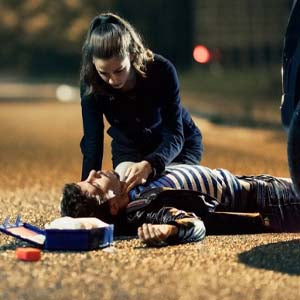Home / Safety & First Aid Courses / First Aid Training for Teenagers
1
/
of
1
First Aid Training for Teenagers
First Aid Training for Teenagers
Regular price
$299.00
Regular price
Sale price
$299.00
Unit price
/
per
First aid training for teenagers is a valuable opportunity to empower young people with essential life-saving skills and knowledge. Equipping teenagers with the ability to respond effectively to emergencies not only prepares them to assist others in need but also instills confidence and a sense of responsibility. Whether at home, school, or in their communities, teenagers can play a critical role in providing immediate assistance during medical emergencies.
Couldn't load pickup availability


Category: Safety & First Aid Courses
View full details

Description
One of the primary objectives of first aid training for teenagers is to teach them how to assess situations quickly and respond appropriately. This includes recognizing signs of distress or injury in others, assessing the severity of the situation, and taking appropriate action to provide assistance. By learning how to remain calm and composed in emergency situations, teenagers can make a significant difference in the outcome of an incident.
Cardiopulmonary resuscitation (CPR) is a fundamental skill taught in first aid training for teenagers. CPR is used to maintain blood circulation and oxygenation in someone experiencing cardiac arrest or respiratory failure. Teenagers learn how to perform CPR on adults, children, and infants, including chest compressions and rescue breaths. CPR certification provides teenagers with the confidence and ability to act quickly in life-threatening situations.
In addition to CPR, first aid training for teenagers covers a wide range of topics relevant to common emergencies and injuries. This includes:
First aid training for teenagers is typically interactive and hands-on, allowing participants to practice skills in simulated scenarios. This approach helps reinforce learning and builds confidence in their ability to respond effectively in real-life situations.
Teenagers who complete first aid training gain valuable life skills that can benefit them throughout their lives. In addition to being able to provide assistance during emergencies, they develop qualities such as leadership, teamwork, and empathy. By empowering teenagers with the knowledge and skills to respond effectively to emergencies, first aid training helps create safer and more resilient communities
Cardiopulmonary resuscitation (CPR) is a fundamental skill taught in first aid training for teenagers. CPR is used to maintain blood circulation and oxygenation in someone experiencing cardiac arrest or respiratory failure. Teenagers learn how to perform CPR on adults, children, and infants, including chest compressions and rescue breaths. CPR certification provides teenagers with the confidence and ability to act quickly in life-threatening situations.
In addition to CPR, first aid training for teenagers covers a wide range of topics relevant to common emergencies and injuries. This includes:
- Choking management: Teenagers learn how to recognize the signs of choking and how to perform abdominal thrusts (Heimlich maneuver) to dislodge a blockage from the airway. Knowing how to respond quickly to a choking emergency can prevent asphyxiation and save lives.
- Wound care: Teenagers are taught how to clean and dress minor wounds, cuts, and scrapes to prevent infection and promote healing. Proper wound care techniques, such as cleaning with soap and water, applying antiseptic, and covering with a bandage, are emphasized.
- Fracture management: Teenagers learn how to recognize signs of fractures and how to provide initial care, including immobilization and support. Proper handling and stabilization of fractures can prevent further injury and reduce pain.
- Bleeding control: Teenagers are trained in techniques to control bleeding, including applying direct pressure to wounds and elevating injured limbs. Knowing how to manage bleeding effectively can prevent excessive blood loss and promote recovery.
- First aid for burns, allergic reactions, and other medical emergencies: Teenagers learn how to recognize and respond to various medical emergencies, including burns, allergic reactions, seizures, and diabetic emergencies. They also learn when to seek professional medical help and how to communicate effectively with emergency services.
First aid training for teenagers is typically interactive and hands-on, allowing participants to practice skills in simulated scenarios. This approach helps reinforce learning and builds confidence in their ability to respond effectively in real-life situations.
Teenagers who complete first aid training gain valuable life skills that can benefit them throughout their lives. In addition to being able to provide assistance during emergencies, they develop qualities such as leadership, teamwork, and empathy. By empowering teenagers with the knowledge and skills to respond effectively to emergencies, first aid training helps create safer and more resilient communities

